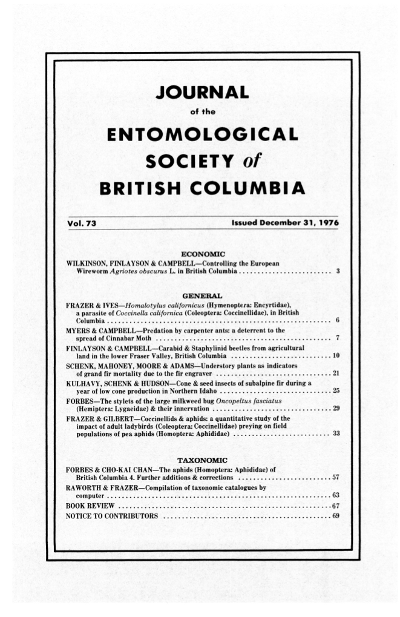Carabid and Staphylinid beetles from agricultural land in the lower Fraser Valley, British Columbia
Keywords:
Carabidae, StaphylinidaeAbstract
Pit-traps were emptied every two or three days for two seasons in crop, fallow, and grass plots to determine the species and population density of Carabidae and Staphylinidae associated with agricultural land, and their relationship with brassica crops. Half of the plots were enclosed by plastic barriers and the beetles were trapped to extinction: half were not enclosed. Thirty-three carabid and 16 staphylinid species were captured. The dominant species was the small, generalized. European carabid predator, <i>Bembidion lampros</i>, which had a population on crop and fallow land of about 29000/hectare. It was almost absent in grass. Other numerous carabids were <i>Harpalus aeneus</i>, <i>Calathus fuscipes</i>, and <i>Clivina fossor</i>, all introduced European spp., with populations of almost 2000, 5600, and llOOO/hectare respectively. The first and third of these were scarce in grassland but the second was abundant. In plots of Brussels sprouts <i>Aleochara bilineata</i>, a staphylinid, was effectively parasitic on root maggots, and averaged more than 6000/hectare. Soil cores taken in October centred on a Brussels sprouts plant averaged 26.4 <i>Hylemya puparia</i> per core of which 44% were parasitized by <i>A. bilineata</i>.References
Briggs, J.B. 1957. Some experiments on control of ground beetle damage to strawberry. 44th Rep. E. Mailing Res. Sta. 1955-1956. 142-145.
Coaker, T.H. 1965. Further experiments on the effect of beetle predators on the numbers of cabbage root fly. Erioischia brassicae (Bouche), attacking brassica crops. Ann. Appl. Biol. 56:7-20.
Coaker, T.H. and D.A. Williams. 1963. The importance of some Carabidae and Staphylinidae as predators of the cabbage root fly, Erioischia brassicae (Bouche). Ent. Exp. et Eppl. 6:156-164.
Finlayson, D.G., C.J. Campbell, and H.A. Roberts. 1975. Herbicides and insecticides: their compatibility and effects on weeds, insects and earthworms in the minicauliflower crop. Ann. Appl. Biol. 79:95-108.
Gibson, A. and R.C. Treherne. 1916. The cabbage root maggot and its control in Canada with notes on the imported onion maggot and seed-corn maggot. Canada Dep. Agr. Entomol. Branch Bull 12. 58 pp.
Greenslade, P.J.M. 1964. Pitfall trapping as a method for studying populations of Carabidae (Coleoptera). J. Anim. Ecol. 33:301-310.
Hatch, M.H. 1953. The beetles of the Pacific northwest. Part I: Introduction and Adephaga. Univ. of Wash. Press, Seattle.
Hatch, M.H. 1957. The beetles of the Pacific northwest. Part II: Staphyliniformia. Univ. of Wash. Press, Seattle.
Tsinovskii, Ya.P. 1961. Clivina fossor L., a pest of corn in the environment of Latvian SSR. Tr. lnst. Biol. Akad. Navk. Latviisk. SSR 20:163-164 (#15685 Biol. Abs. 42:1237, 1963).
Wilkes, G. and G. Wishart. 1953. Studies on parasites of root maggots (Hylemya spp.; Diptera: Anthomyiidae) in the Netherlands in relation to their control in Canada. Tijdschr. PPziebt. 59:185-188.
Wishart, G., J.F. Doane, and G.E. Maybe. 1956. Notes on beetles a predators of eggs of Hylemyia brassicae (Bouche). Canadian Entomol. 88:634-639.
Wright, D.W. 1956. Entomology report. Rep. Nat. Veg. Res. Sta. Wellesbourne (1955). 47.
Wright, D.W., H.D. Hughes, and J. Worrall. 1960. The effect of certain predators on the numbers of cabbage root fly (Erioischia brassicae (Bouche)) and on subsequent damage caused by the pest. Ann. Appl. Biol. 48:756-763.
Downloads
Published
Issue
Section
License
Authors who publish with the Journal of the Entomological Society of British Columbia agree to the following terms:
-Authors retain copyright and grant the journal right of first publication with the work simultaneously licensed under a Creative Commons Attribution License that allows others to share the work with an acknowledgement of the work's authorship and initial publication in this journal.
-Authors are able to enter into separate, additional contractual arrangements for the non-exclusive distribution of the journal's published version of the work (e.g., post it to an institutional repository or publish it in a book), with an acknowledgement of its initial publication in this journal.
-Authors are permitted and encouraged to post their work online (e.g., in institutional repositories or on their website) prior to and during the submission process, as it can lead to productive exchanges, as well as earlier and greater citation of published work (See The Effect of Open Access).


